Optimal Chainlength - It's A New Day
Moderator: robbosmans
On Shimano latest gen (and Sram non 1x Clutch RD):
Small ring + Small cog and Big ring + Small cog place top pulley at the same place, as does without chain + set derailleur at Small cog position.
Small ring + Big cog and Big ring + Big cog place top pulley at the same place, as does without chain + set derailleur at Big cog position.
Only cage rotation changes. When adjust B-screw we don't need to check both big ring and small ring, just either one, it put top pulley at the same place.
Therefore, just adjust B-screw to put top pulley at closest position to the cassette without actually hitting the cassette or being too close that chain will jam between them (on both big cog and small cog position). Do it either when chain on or not is all fine. If you adjust B-screw before putting chain on, it help you judge chain length easier (with small+small through RD pulley way).
Small ring + Small cog and Big ring + Small cog place top pulley at the same place, as does without chain + set derailleur at Small cog position.
Small ring + Big cog and Big ring + Big cog place top pulley at the same place, as does without chain + set derailleur at Big cog position.
Only cage rotation changes. When adjust B-screw we don't need to check both big ring and small ring, just either one, it put top pulley at the same place.
Therefore, just adjust B-screw to put top pulley at closest position to the cassette without actually hitting the cassette or being too close that chain will jam between them (on both big cog and small cog position). Do it either when chain on or not is all fine. If you adjust B-screw before putting chain on, it help you judge chain length easier (with small+small through RD pulley way).

Visit starbike.com Online Retailer for HighEnd cycling components
Great Prices ✓ Broad Selection ✓ Worldwide Delivery ✓
www.starbike.com
@Biggergear: I think you’ll be quite fine just sizing it for the 28 and adjusting the b-screw a bit when you throw on the 25. The difference isn’t that big and I don’t think it’ll be a problem. I’ve seen some big gaps where the owner thinks the shifting is “perfect”. It’s not but clearly it’s good enough. I suppose “perfect” is subject to interpretation. If you’re talking about a 25 to a 32 largest cog cassette, that may be different. But for those of us that like optimal shifting all the time, the thought of anything less is, well... I just can’t think about it.
I will be interested to see how the new Campy 12sp stuff plays out in this regard. Similar placement of the derailleur in space... we’ll see.
I will be interested to see how the new Campy 12sp stuff plays out in this regard. Similar placement of the derailleur in space... we’ll see.
Colnago C64 - The Naked Build; Colnago C60 - PR99; Trek Koppenberg - Where Emonda and Domane Meet;
Unlinked Builds (searchable): Colnago C59 - 5 Years Later; Trek Emonda SL Campagnolo SR; Special Colnago EPQ
Unlinked Builds (searchable): Colnago C59 - 5 Years Later; Trek Emonda SL Campagnolo SR; Special Colnago EPQ
Calnago - Didn't you consider writing all your stuff in the form of articles and publishing it either somewhere like VeloNews, CyclingTips, or simply at your own blog? I think it's well thought out, comprehensive, valuable and useful content, you've given it a lot of time and effort and it's really worth being put somewhere as articles with all that information at one place, in easily readable form, organized by topics for example etc.
One problem here is that you end up with like 5-10 pages with lots of posts to go through, searching for older topics could be sometimes a little lengthy process and so on.
And in this online era you can easily update your article if you need to, you can still refer to them from here or the other way round, or even have some comments section under each article.. there aren't many limitations.
One problem here is that you end up with like 5-10 pages with lots of posts to go through, searching for older topics could be sometimes a little lengthy process and so on.
And in this online era you can easily update your article if you need to, you can still refer to them from here or the other way round, or even have some comments section under each article.. there aren't many limitations.
That is my concern maybe I want to throw a 32 on when I go to another terrain.Bigger Gear wrote:I think one of the unfortunate downsides to the 91xx/80xx series is that for a rider who has multiple wheels and likes to use different cassette combos then chain sizing the new Shimano way is a bit of problem. For example, I have 12-25 cassettes that I use for most of my flat/rolling riding around home. But I also have 11-28 cassettes that I prefer if I am ridign in mountainous terrain. Ideally now, I think I would need a longer chain when going from the 12-25 to the 11-28, but I haven't played around too much to see if that is the case.
Thanks for the detailed work here Cal!
Going to have to readjust and maybe get adequate shifting.
Sent from my SM-G965U using Tapatalk
Ha... and I certainly remember those days. I was just as bad back then... if those pulleys didn't line up vertically with the axle, I couldn't sleep at night.
Colnago C64 - The Naked Build; Colnago C60 - PR99; Trek Koppenberg - Where Emonda and Domane Meet;
Unlinked Builds (searchable): Colnago C59 - 5 Years Later; Trek Emonda SL Campagnolo SR; Special Colnago EPQ
Unlinked Builds (searchable): Colnago C59 - 5 Years Later; Trek Emonda SL Campagnolo SR; Special Colnago EPQ
@mag: I'm glad you find my posts informative and hope others do too. At this point, I've not bothered to create my own site or anything like that, despite requests to do so from time to time. Wouldn't that be kind of like a jobmag wrote: ↑Fri Jun 29, 2018 1:16 amCalnago - Didn't you consider writing all your stuff in the form of articles and publishing it either somewhere like VeloNews, CyclingTips, or simply at your own blog? I think it's well thought out, comprehensive, valuable and useful content, you've given it a lot of time and effort and it's really worth being put somewhere as articles with all that information at one place, in easily readable form, organized by topics for example etc.
One problem here is that you end up with like 5-10 pages with lots of posts to go through, searching for older topics could be sometimes a little lengthy process and so on.
And in this online era you can easily update your article if you need to, you can still refer to them from here or the other way round, or even have some comments section under each article.. there aren't many limitations.
Colnago C64 - The Naked Build; Colnago C60 - PR99; Trek Koppenberg - Where Emonda and Domane Meet;
Unlinked Builds (searchable): Colnago C59 - 5 Years Later; Trek Emonda SL Campagnolo SR; Special Colnago EPQ
Unlinked Builds (searchable): Colnago C59 - 5 Years Later; Trek Emonda SL Campagnolo SR; Special Colnago EPQ
You're exactly right @Svetty... as I stated earlier, the equation doesn't take today's derailleur designs into account. It is nothing more than a determination of the shortest length that you can have to wrap around two pulleys, or chainring/cog in the case of a bicycle, with a little bit added (the +1) to account for the cage pass through. But it by no means ensures that you will have the optimal chainlength for any specific situation with today's crop of wide range cassettes and derailleurs of different designs with mutliple cage length versions available, depending on setup.
To illustrate, heres a couple of examples...
First... the example I presented at the beginning of the thread... here's how big/big would look if strict application of the "equation" method were used...
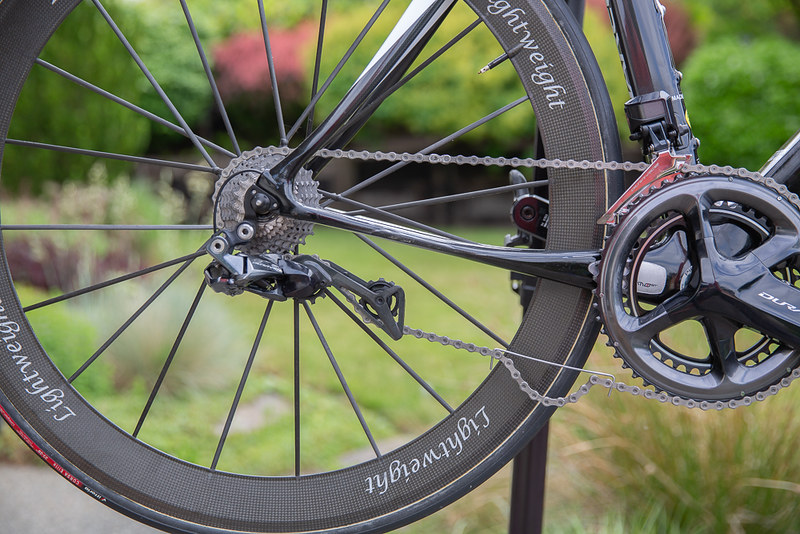
In the above pic, the chain physically "fits", but I think any decent mechanic would say... "hmmm, not really liking that very much".
So, heres another example, this time with a Campy setup. Keep in mind that the Campy method of determining chainlength (prior to 12sp), always ensured that you end up with the longest chain possible and could thus use any cassette you wanted (within the derailleurs capacity) and be confident it would work. This is a big benefit of today's derailleurs being able to wrap enough chain properly to enable that, unlike derailleurs of old. For instance, setting up the chain using the Campy method of small/small with an 11 tooth smallest cog cassette allows you to throw in any wheelset/cassette you want, ranging from 11/23 right on up to 11/29, assuming the chainrings don't change. And with the "H" screw, you could dial in the distance from the upper pulley to the cogs to within 5mm (yes, I've tested them all). Fabulous. But if you applied the equation method to this Campy drivetrain below (39/53 chainrings, 11/25 cassette), you would end up with chain that is 4 links short of what I consider optimal as well as rule out throwing on a cassette with the 29 cog. And then there are always the marginal cases where the optimal chainlength may be an either/or situation, where good judgement takes over, always. So, would you be happy with a chain that looked like this in Big/Big... after all, it fits....
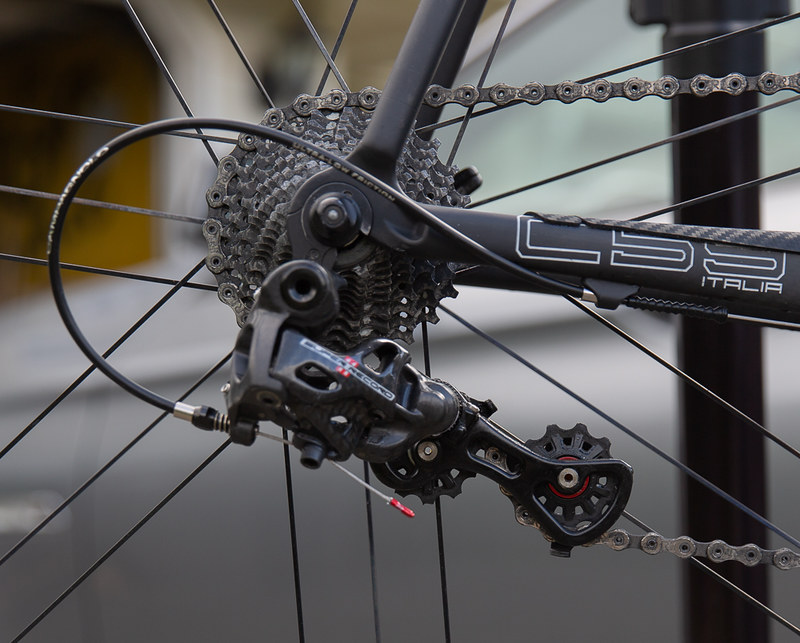
I think it's safe to say that it hurts to look at the cage being stretched out like it is being stretched above. So much for the equation method.
Here's what the optimal chainlength for this Campy setup looks like on big/big...
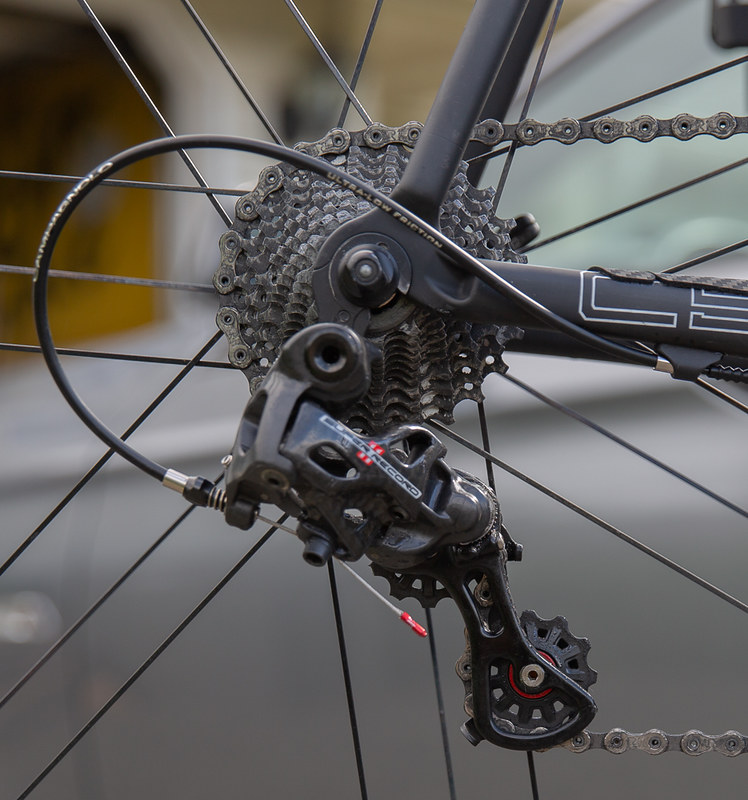
And the same optimal chainlength (as above) on small/small...
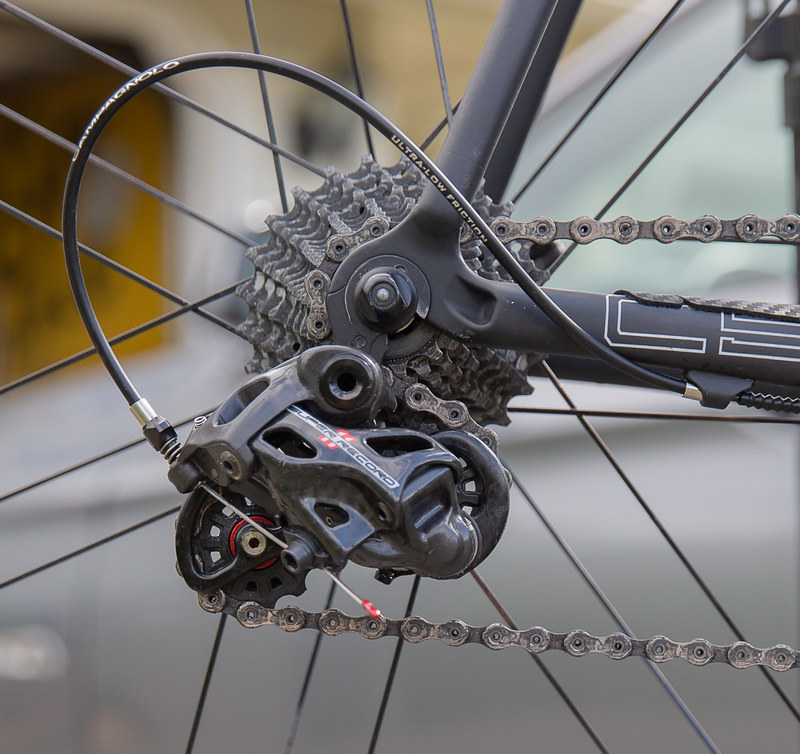
With this chainlength, you are still able to thrown on an 11/29 cassette and use the H-screw to adjust the pulley/cog distance to where it needs to be.
Thus, in the past I would by and large use the small/small method regardless of whether it was a Shimano drivetrain or a Campy drivetrain, simply because it would allow the use of more cassettes of varying ranges. But these days, I use the Shimano method as I outlined earlier for Shimano drivetrains, as using the small/small method can easily play tricks on you when you see all the slack that may be present in small/small assuming you're using a mechanical system and even more difficult with Di2 since it blocks you out of the two smallest cogs when in the small chainring.
Shimano supplies several derailleurs with varying length cages these days to accommodate the ever growing ranges of their cassettes... there is no one size fits all anymore. Or at least no one size that will work equally well across all cassettes.
Colnago C64 - The Naked Build; Colnago C60 - PR99; Trek Koppenberg - Where Emonda and Domane Meet;
Unlinked Builds (searchable): Colnago C59 - 5 Years Later; Trek Emonda SL Campagnolo SR; Special Colnago EPQ
Unlinked Builds (searchable): Colnago C59 - 5 Years Later; Trek Emonda SL Campagnolo SR; Special Colnago EPQ
Optimal Chainlength - Part 2
Ok, so I was originally going to add this next part to the thread on Direct Mount Hangers, but I think if you've read or were interested in this thread and you've worked with the new Shimano road derailleurs enough, you've probably experienced a case or two where the rear wheel can be difficult or finicky to remove. So, that's what I'm going to explore a bit more here...
Using the example with Pinarello K8-S I showed earlier, I'll just show it again, with the proper length chain...

Ok, looks fine... nice wrap well forward of the axle and when in small ring/big cog, the upper pulley is very close to the cassette, yet not clashing... it's what you strive for. So, what's the problem? Well, in this case, you can't remove the rear wheel without deflating the tire. It's only a 25mm tire at best, mounted on a narrow 20mm external width clincher rim. And you can't remove the rear wheel without deflating the tire. Damn, that ain't right. Luckily, it's not that common, but it's common enough that it can be a real annoyance if you're affected by it.
First of all, let me once again reinforce that whether or not you have a Direct Mount hanger is completely irrelevant with respect to this issue. The derailleur should be positioned in the same place in space regardless of whether you are attaching the derailleur (without the B-link) to a DM hanger or using the B-link to attach it to a regular hanger. I still note people thinking that a DM hanger will solve this issue. It won't, unless you modify the hanger in such a way that it positions it further back from where Shimano has spec'd it out to be, but that detracts from it's intended design to a certain extent, more on that in a bit. The issue arises in certain cases (like this one), where there is a lot of material behind the bottom bracket, lessening the clearance between the front of the tire and the BB shell when you try to remove the tire. Any early rumors that the DM hanger was supposed to make rear wheel removal easier were/are completely wrong.
Let's have a look at the hangup... In the pic below I'm attempting to remove the rear wheel, but the cassette/chain can't clear the upper pulley. The wheel can't go forward any further since it's jamming up against the bottom bracket shell, and the derailleur is back as far as it can go (there's a stop on the hanger specifically intended to prevent the derailleur from being forced back beyond that point)...
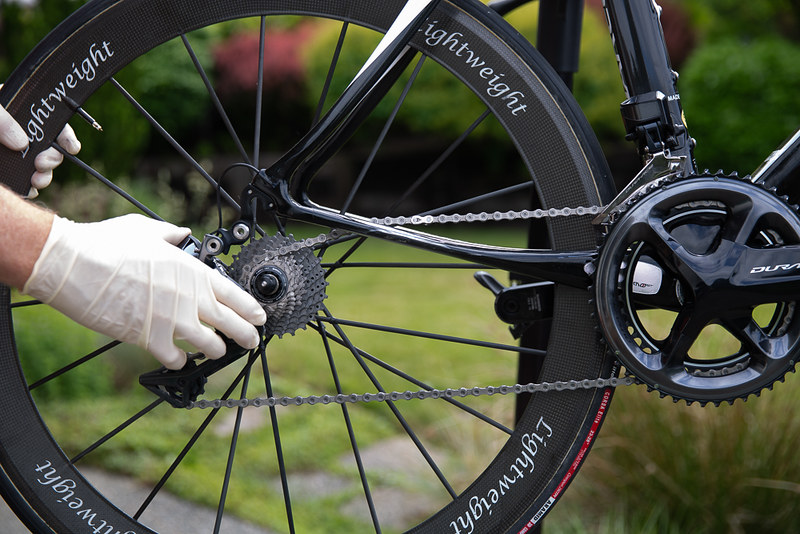
In the above pic, the cassette can't clear the upper pulley, which is kind of hidden behind my index finger as I pull it back as far as it can go. You're going to have to trust me that the pulley is indeed jamming into the cassette behind my index finger as I only had so many hands to hold things and get a pic taken at the same time. The wheel can't go forward anymore since it's jammed up against the bottom bracket shell. Swearing usually ensues at this point. But imagine if you were trying to change some pros wheel in an important race... really bad swearing ensues. So, let's visit Team Sky's workaround last year to this issue... at least in the case of Michael Kwaitowski's bike setup...
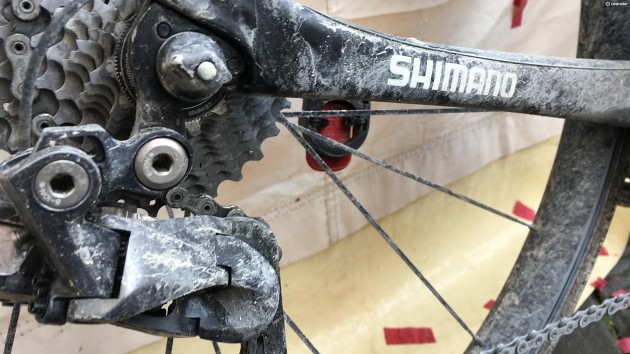
The above pic is credit to @jwfinesse, who posted it when discussing this very same problem in a thread started by @beanbiken. For reference, here's a link... Rear Wheel Removal
So what's different in his setup you might ask. Simply, the b-link has been pivoted back a bit from the stop on the derailleur hanger. It goes against Shimano's guidelines, as when you do that, the only thing holding it securely is the torque from the mounting bolt as it's no longer resting against derailleur hanger stop.
I did the same thing in my example...
First, I'll repeat the pic of the unaltered position of the b-link when it is positioned to how it "should be"... it angles downwards and towards the rear. In this position, I can't remove the rear wheel without deflating it...
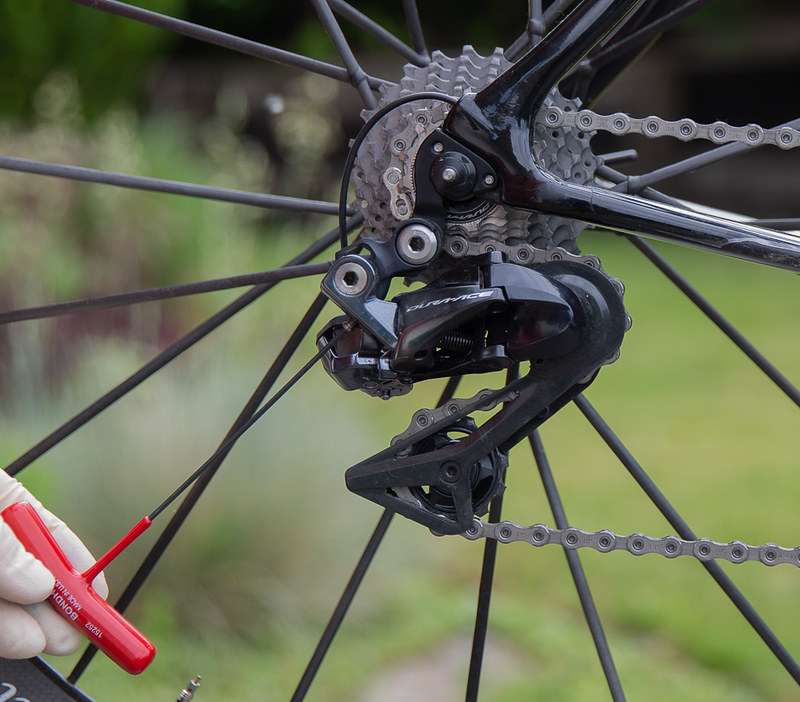
I also want you to to note the position of the upper pulley in relation to the cogs... it is very close, and that's a good thing as far as shifting performance goes. Keep that vision of how close the pulley is to the cogs in your mind for a second, because I'm not done talking about it just yet.
Now, look at this next pic, where I've loosened the mounting bolt and pivoted the rear derailleur back just a bit from the stop so that the b-link is now pointing pretty horizontal (maybe even upwards a smidge) and towards the rear, essentially moving the whole assembly just several millimeters rearward...
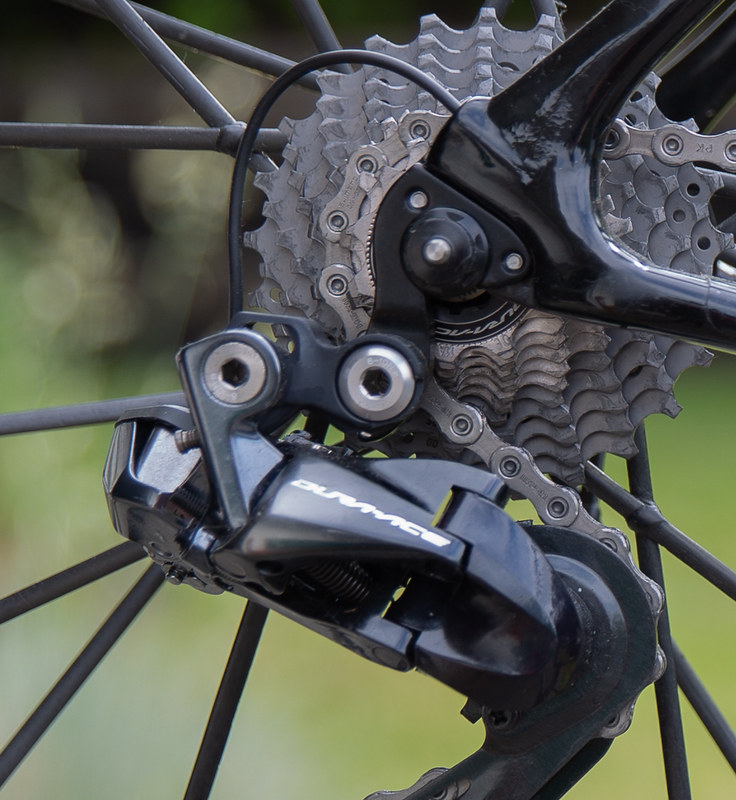
And from just doing that... guess what... rear wheel pops out without having to deflate the tire...
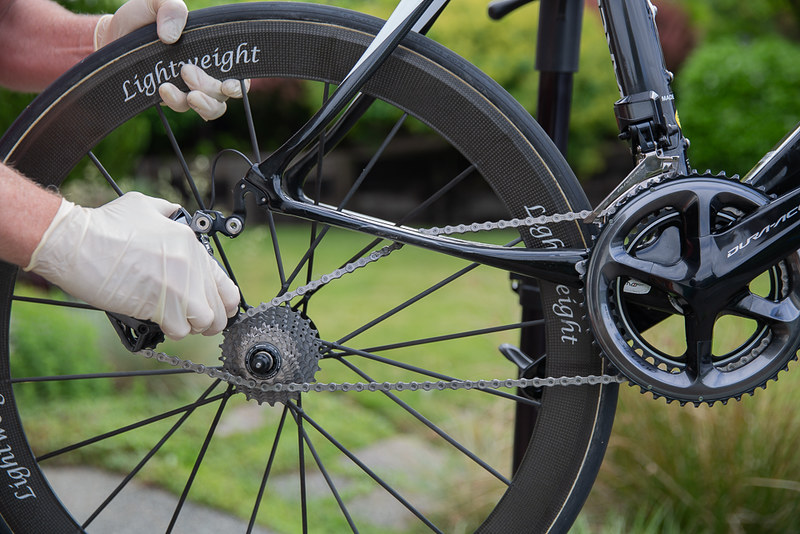
But what has happened here. Well, firstly... if you do this, you'd better torque that mounting bolt very tightly because that is the only force preventing it from slipping as it's no longer got the stop tab to sit against. But secondly, and here's where you can really see how sensitive the derailleur is to being mounted in the right place in space... look at this next pic and take note of how far away from the cogs the upper pulley has moved, and this is as close as I can now adjust it...
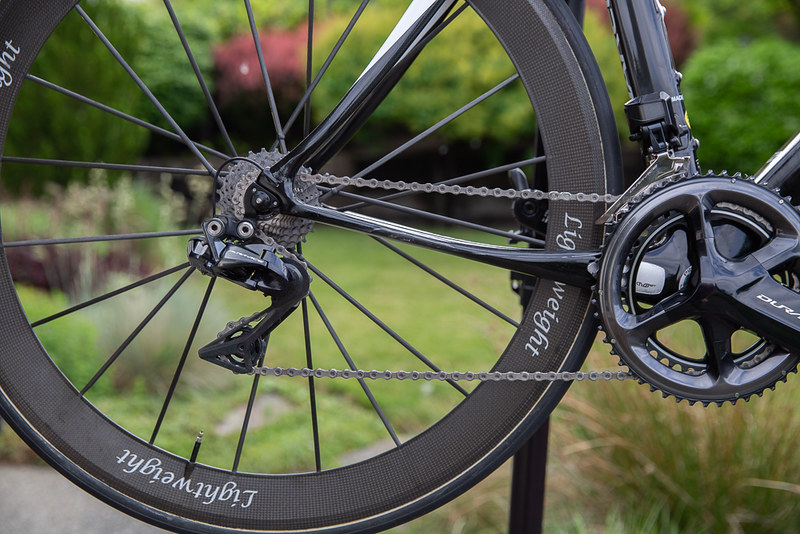
And one more pic with chain on small ring/big cog just to show the increased distance from upper pulley and the big cog is under this scenario...
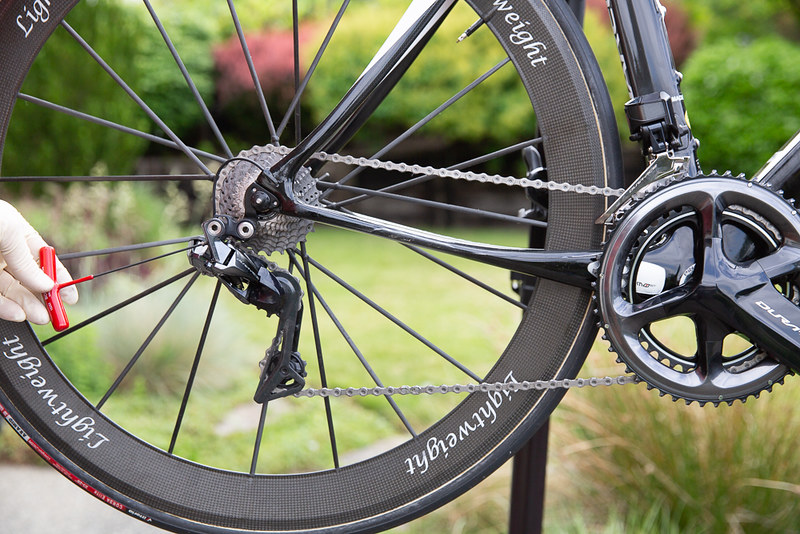
So in the end, the rear wheel removal issue was solved by pivoting the derailleur back just a bit from where it would normally rest against the stop tab on the hanger, but if you do that you'd better ensure that you torque it down good and tight for obvious reasons. But the downside, aside from a less secure mounting, is that the shifting has been degraded slightly due to the increased distance of the upper pulley from the cogs. I tested out the shifting and yes, it was degraded from what it could be had it not been pivoted rearward. Does it still shift... of course, and it shifts quite well... but just not quite as nice as it does when it's where it should be, and that's too bad. Just some stuff to think about if you run into this situation.
Ok... so how can I tell beforehand if I'm going to have a rear wheel removal issue with Shimano's new rear derailleur designs...
Let's assume about a 25mm road tire as kind of a rough benchmark in tire size for a moment and adjust accordingly if you're using tires bigger or smaller than that. What I've found is that if there is about 350mm or less distance from the inside of the bottom bracket shell to the center of the rear axle, you could find yourself in this position... I've measured this on a couple different bikes with the issue, or close to it, and it seems pretty consistent....
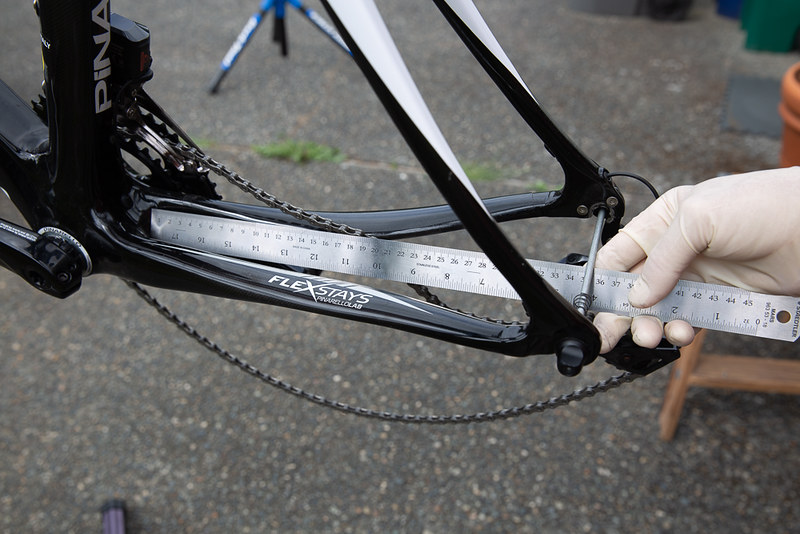
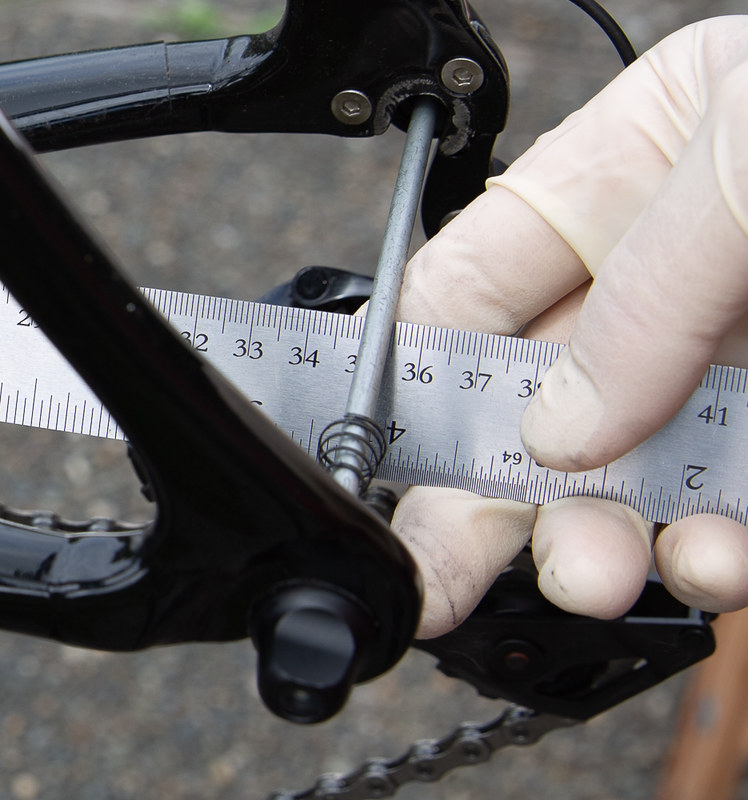
But I have disc brakes with a thru axle, so my wheel doesn't have to move forward to come out, it just drops down, so I'm ok, right?...
Well, maybe, maybe not. It's not the forward slanting road dropout that is usually the hangup here. It's the position of the upper pulley, and that doesn't change. So no, the fact that you may have a thru axle isn't going to be much consolation by itself. However, the chances that you'll have longer chainstays are greater with discs, and so long as there isn't too much materal behind the bottom bracket you might just be fine. It's really more a function of tire size, and how much clearance is in front of that tire and behind the bottom bracket shell, or in the case of really slack or thick seat tubes, that could possibly be a limiter as well.
And what about the new Campy 12sp stuff, same issue?
I just don't know as I haven't installed or played with any yet. But I haven't heard anything to that effect yet. Although when the new Shimano stuff came out, everyone was running around saying it makes rear wheel removal easier. Then when it didn't those same folks started saying "oh... well... you just need a proper direct mount hanger, then it will". And no, it doesn't, as it doesn't change the ultimate position of the derailleur in space. I don't think any Shimano docs ever mentioned that as a feature in the first place, rather... the new derailleurs allowed for wider range cassettes while still maintaining good wraparound on the smaller cogs too. I think the rumor must have begun as a result of someone seeing how far rearward the new mounting position was and assuming that had to make rear wheel removal easier.
So what's Team Sky doing now?
Good question... they are sporting some new direct mount hangers, and unless Pinarello has added a bit more clearance between the rear tire and the bb shell, then I would presume that those new hangers place the derailleur just a bit further rearwards than you could achieve with a stock bike and regular hanger plus b-link...
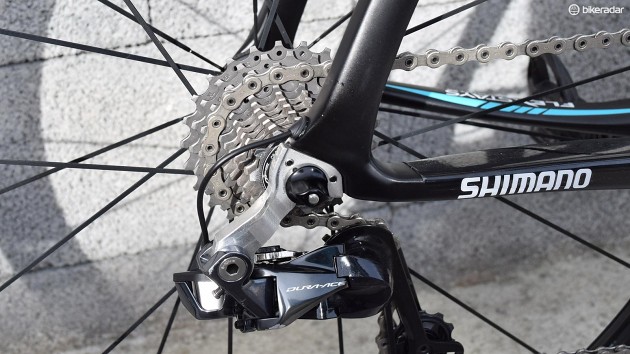
Hard to say exactly what geomtery that hanger in the pic is using and how it may differ (if it even does) from the Shimano spec, but it doesn't look like the stop on the rear of the hanger has been removed to me. That was another "trick" that one could do... grind down the tab on the rear of the b-link so that the derailleur can be yanked back in truly hurtful regions, but I wouldn't recommend that. So, I suspect it's just altered a bit to ensure that all their team bikes in all sizes don't have issues with rear wheel removal.
In conclusion, I hope this thread helps the mechanics amongst us, and the more astute "I want to know too" home mechanics out there a bit when and if they come across this situation.
Thanks for reading,
Cal
Ok, so I was originally going to add this next part to the thread on Direct Mount Hangers, but I think if you've read or were interested in this thread and you've worked with the new Shimano road derailleurs enough, you've probably experienced a case or two where the rear wheel can be difficult or finicky to remove. So, that's what I'm going to explore a bit more here...
Using the example with Pinarello K8-S I showed earlier, I'll just show it again, with the proper length chain...

Ok, looks fine... nice wrap well forward of the axle and when in small ring/big cog, the upper pulley is very close to the cassette, yet not clashing... it's what you strive for. So, what's the problem? Well, in this case, you can't remove the rear wheel without deflating the tire. It's only a 25mm tire at best, mounted on a narrow 20mm external width clincher rim. And you can't remove the rear wheel without deflating the tire. Damn, that ain't right. Luckily, it's not that common, but it's common enough that it can be a real annoyance if you're affected by it.
First of all, let me once again reinforce that whether or not you have a Direct Mount hanger is completely irrelevant with respect to this issue. The derailleur should be positioned in the same place in space regardless of whether you are attaching the derailleur (without the B-link) to a DM hanger or using the B-link to attach it to a regular hanger. I still note people thinking that a DM hanger will solve this issue. It won't, unless you modify the hanger in such a way that it positions it further back from where Shimano has spec'd it out to be, but that detracts from it's intended design to a certain extent, more on that in a bit. The issue arises in certain cases (like this one), where there is a lot of material behind the bottom bracket, lessening the clearance between the front of the tire and the BB shell when you try to remove the tire. Any early rumors that the DM hanger was supposed to make rear wheel removal easier were/are completely wrong.
Let's have a look at the hangup... In the pic below I'm attempting to remove the rear wheel, but the cassette/chain can't clear the upper pulley. The wheel can't go forward any further since it's jamming up against the bottom bracket shell, and the derailleur is back as far as it can go (there's a stop on the hanger specifically intended to prevent the derailleur from being forced back beyond that point)...

In the above pic, the cassette can't clear the upper pulley, which is kind of hidden behind my index finger as I pull it back as far as it can go. You're going to have to trust me that the pulley is indeed jamming into the cassette behind my index finger as I only had so many hands to hold things and get a pic taken at the same time. The wheel can't go forward anymore since it's jammed up against the bottom bracket shell. Swearing usually ensues at this point. But imagine if you were trying to change some pros wheel in an important race... really bad swearing ensues. So, let's visit Team Sky's workaround last year to this issue... at least in the case of Michael Kwaitowski's bike setup...

The above pic is credit to @jwfinesse, who posted it when discussing this very same problem in a thread started by @beanbiken. For reference, here's a link... Rear Wheel Removal
So what's different in his setup you might ask. Simply, the b-link has been pivoted back a bit from the stop on the derailleur hanger. It goes against Shimano's guidelines, as when you do that, the only thing holding it securely is the torque from the mounting bolt as it's no longer resting against derailleur hanger stop.
I did the same thing in my example...
First, I'll repeat the pic of the unaltered position of the b-link when it is positioned to how it "should be"... it angles downwards and towards the rear. In this position, I can't remove the rear wheel without deflating it...

I also want you to to note the position of the upper pulley in relation to the cogs... it is very close, and that's a good thing as far as shifting performance goes. Keep that vision of how close the pulley is to the cogs in your mind for a second, because I'm not done talking about it just yet.
Now, look at this next pic, where I've loosened the mounting bolt and pivoted the rear derailleur back just a bit from the stop so that the b-link is now pointing pretty horizontal (maybe even upwards a smidge) and towards the rear, essentially moving the whole assembly just several millimeters rearward...

And from just doing that... guess what... rear wheel pops out without having to deflate the tire...

But what has happened here. Well, firstly... if you do this, you'd better torque that mounting bolt very tightly because that is the only force preventing it from slipping as it's no longer got the stop tab to sit against. But secondly, and here's where you can really see how sensitive the derailleur is to being mounted in the right place in space... look at this next pic and take note of how far away from the cogs the upper pulley has moved, and this is as close as I can now adjust it...

And one more pic with chain on small ring/big cog just to show the increased distance from upper pulley and the big cog is under this scenario...

So in the end, the rear wheel removal issue was solved by pivoting the derailleur back just a bit from where it would normally rest against the stop tab on the hanger, but if you do that you'd better ensure that you torque it down good and tight for obvious reasons. But the downside, aside from a less secure mounting, is that the shifting has been degraded slightly due to the increased distance of the upper pulley from the cogs. I tested out the shifting and yes, it was degraded from what it could be had it not been pivoted rearward. Does it still shift... of course, and it shifts quite well... but just not quite as nice as it does when it's where it should be, and that's too bad. Just some stuff to think about if you run into this situation.
Ok... so how can I tell beforehand if I'm going to have a rear wheel removal issue with Shimano's new rear derailleur designs...
Let's assume about a 25mm road tire as kind of a rough benchmark in tire size for a moment and adjust accordingly if you're using tires bigger or smaller than that. What I've found is that if there is about 350mm or less distance from the inside of the bottom bracket shell to the center of the rear axle, you could find yourself in this position... I've measured this on a couple different bikes with the issue, or close to it, and it seems pretty consistent....


But I have disc brakes with a thru axle, so my wheel doesn't have to move forward to come out, it just drops down, so I'm ok, right?...
Well, maybe, maybe not. It's not the forward slanting road dropout that is usually the hangup here. It's the position of the upper pulley, and that doesn't change. So no, the fact that you may have a thru axle isn't going to be much consolation by itself. However, the chances that you'll have longer chainstays are greater with discs, and so long as there isn't too much materal behind the bottom bracket you might just be fine. It's really more a function of tire size, and how much clearance is in front of that tire and behind the bottom bracket shell, or in the case of really slack or thick seat tubes, that could possibly be a limiter as well.
And what about the new Campy 12sp stuff, same issue?
I just don't know as I haven't installed or played with any yet. But I haven't heard anything to that effect yet. Although when the new Shimano stuff came out, everyone was running around saying it makes rear wheel removal easier. Then when it didn't those same folks started saying "oh... well... you just need a proper direct mount hanger, then it will". And no, it doesn't, as it doesn't change the ultimate position of the derailleur in space. I don't think any Shimano docs ever mentioned that as a feature in the first place, rather... the new derailleurs allowed for wider range cassettes while still maintaining good wraparound on the smaller cogs too. I think the rumor must have begun as a result of someone seeing how far rearward the new mounting position was and assuming that had to make rear wheel removal easier.
So what's Team Sky doing now?
Good question... they are sporting some new direct mount hangers, and unless Pinarello has added a bit more clearance between the rear tire and the bb shell, then I would presume that those new hangers place the derailleur just a bit further rearwards than you could achieve with a stock bike and regular hanger plus b-link...

Hard to say exactly what geomtery that hanger in the pic is using and how it may differ (if it even does) from the Shimano spec, but it doesn't look like the stop on the rear of the hanger has been removed to me. That was another "trick" that one could do... grind down the tab on the rear of the b-link so that the derailleur can be yanked back in truly hurtful regions, but I wouldn't recommend that. So, I suspect it's just altered a bit to ensure that all their team bikes in all sizes don't have issues with rear wheel removal.
In conclusion, I hope this thread helps the mechanics amongst us, and the more astute "I want to know too" home mechanics out there a bit when and if they come across this situation.
Thanks for reading,
Cal
Colnago C64 - The Naked Build; Colnago C60 - PR99; Trek Koppenberg - Where Emonda and Domane Meet;
Unlinked Builds (searchable): Colnago C59 - 5 Years Later; Trek Emonda SL Campagnolo SR; Special Colnago EPQ
Unlinked Builds (searchable): Colnago C59 - 5 Years Later; Trek Emonda SL Campagnolo SR; Special Colnago EPQ
Don’t know how the oversize pulleys of the Ceramic Speed cage would affect things. I think the upper pulley is just a little bigger, and the lower is huge. If you have a frame where rear wheel removal is an issue with the newest Shimano stuff, then every bit the diameter increases on the upper pulley is going to make it even harder to remove the rear wheel without compensating somewhere else. Bottom pulley not so much. As for chain length, any time you have more wrap around larger pulleys, you “may” need to adjust the chain length a bit, but how they will affect the geometry and operation of the derailleur I don’t know.
I once replaced my cage pulleys while on a cross country cycling trip. I looked at what was available in the bike shop I came across and got mesmerized by some bling alloy pulleys (regular size), and the claim on the packaging was that it reduced friction and lasted much longer since they were made of alloy. How could I go wrong. And they cost a lot so they had to be good, right? Well, I certainly didn’t notice one bit of friction reduction and couldn’t wait to change them back when I got home because, being made of alloy, they were a lot noisier. When it comes to compatibility between drive train parts, I generally like to use what the manufacturer spent so much time perfecting, especially these days.
I once replaced my cage pulleys while on a cross country cycling trip. I looked at what was available in the bike shop I came across and got mesmerized by some bling alloy pulleys (regular size), and the claim on the packaging was that it reduced friction and lasted much longer since they were made of alloy. How could I go wrong. And they cost a lot so they had to be good, right? Well, I certainly didn’t notice one bit of friction reduction and couldn’t wait to change them back when I got home because, being made of alloy, they were a lot noisier. When it comes to compatibility between drive train parts, I generally like to use what the manufacturer spent so much time perfecting, especially these days.
Colnago C64 - The Naked Build; Colnago C60 - PR99; Trek Koppenberg - Where Emonda and Domane Meet;
Unlinked Builds (searchable): Colnago C59 - 5 Years Later; Trek Emonda SL Campagnolo SR; Special Colnago EPQ
Unlinked Builds (searchable): Colnago C59 - 5 Years Later; Trek Emonda SL Campagnolo SR; Special Colnago EPQ
-
BdaGhisallo
- Posts: 3282
- Joined: Wed Mar 17, 2004 1:38 pm
Thank you so much for taking your time and effort to figure this out and post it for the rest of us to learn from. Cheers!
Thanks @BdaGhisallo, I think it was your post about DM hangers this past winter that really got me to actually document what I knew in that thread. The chainlength issues came to light while I was testing those things re the DM hangers. It’s not quite as straightforward as it used to be, for sure.
Colnago C64 - The Naked Build; Colnago C60 - PR99; Trek Koppenberg - Where Emonda and Domane Meet;
Unlinked Builds (searchable): Colnago C59 - 5 Years Later; Trek Emonda SL Campagnolo SR; Special Colnago EPQ
Unlinked Builds (searchable): Colnago C59 - 5 Years Later; Trek Emonda SL Campagnolo SR; Special Colnago EPQ
Great thread, dunno how I missed it before. I have a pretty unrelated question, but it's still about rear wheel removal!
Would you say it's better to select big-small or small-small when removing the rear wheel? (regardless of system, or does it depend?) My intuition tells me it would be easier when in small-small due to there being less tension in the chain, but I'd be interested to hear what you think.
Would you say it's better to select big-small or small-small when removing the rear wheel? (regardless of system, or does it depend?) My intuition tells me it would be easier when in small-small due to there being less tension in the chain, but I'd be interested to hear what you think.
It’s always easier to have the chain in small/small when removing the rear wheel. There is less tension and more slack to pull the derailleur rearward to clear things. But with the new derailleurs the rearward motion is limited, and with Di2, you can’t even get the chain in small/small since it blocks access to the two smallest cogs when in the small ring by default. So get it as close as you can (third cog) and small ring when removing the rear wheel.
Colnago C64 - The Naked Build; Colnago C60 - PR99; Trek Koppenberg - Where Emonda and Domane Meet;
Unlinked Builds (searchable): Colnago C59 - 5 Years Later; Trek Emonda SL Campagnolo SR; Special Colnago EPQ
Unlinked Builds (searchable): Colnago C59 - 5 Years Later; Trek Emonda SL Campagnolo SR; Special Colnago EPQ
-
BdaGhisallo
- Posts: 3282
- Joined: Wed Mar 17, 2004 1:38 pm
To be sure, you can disable this block in the E-Tube software. I run 53-39 rings and a 12-28 cassette and I can shift into every possible gear combination.Calnago wrote: ↑Sat Jul 21, 2018 7:12 pmIt’s always easier to have the chain in small/small when removing the rear wheel. There is less tension and more slack to pull the derailleur rearward to clear things. But with the new derailleurs the rearward motion is limited, and with Di2, you can’t even get the chain in small/small since it blocks access to the two smallest cogs when in the small ring by default. So get it as close as you can (third cog) and small ring when removing the rear wheel.

Visit starbike.com Online Retailer for HighEnd cycling components
Great Prices ✓ Broad Selection ✓ Worldwide Delivery ✓
www.starbike.com






